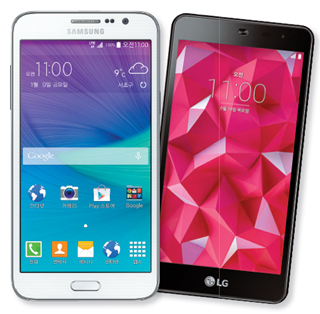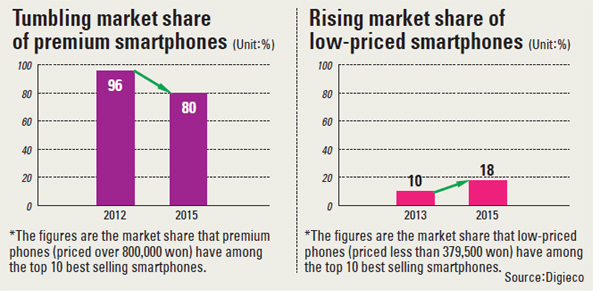Fancy smartphones losing appeal

In 2012, sales of high-end smartphones costing more than 800,000 won ($713) accounted for 96 percent of the 10 best-selling devices, according to Digieco, KT’s economic research institute.
But the days when consumers could freely choose a top-of-the-line device are long gone, following a government regulation limiting subsidies to 330,000 won.
The regulation caused people to shy away from expensive phones, creating a sharp decline in the premium market.

In line with the downbeat performance, sales of premium phones accounted for only 80 percent of the 10 most popular smartphones, down 16 percent from three years ago, since the regulation went into effect, Digieco said in June.
Budget phones, however, are doing better than ever. Sales of devices priced below 379,500 won increased to 18 percent of the best-selling devices this year, from 10 percent in 2013, Digieco said.
Market analysts warn that the decreasing appeal of premium phones will drag down the revenue of local tech giants Samsung Electronics and LG Electronics.
Multiple brokerages also cited the lower-than-expected sales of the Galaxy S6 series and LG’s new G4 as reasons they trimmed estimates for second-quarter earnings.
“High-end phones are not as attractive as before because the amount of money that consumers actually pay has increased,” said Zhang Jung-hyouk, vice president of Atlas Research & Consulting, a smartphone market tracker.
But not all premium smartphones are suffering. Apple significantly increased its market share in Korea with its latest iPhone 6 series.
Putting aside advanced features and larger screens, some analysts believe that the government’s move worked in Apple’s favor.
Before the regulation, telecom companies tended to be more stringent in giving subsidies for iPhones, apparently because of contract terms with Apple. The disparity in subsidies made flagship phones by Samsung Electronics and LG Electronics much cheaper, even though the retail prices are on par with the iPhone models.
As the regulation largely evened out subsidies, there was no price gap between premium phones by the three major smartphone makers, which consequently increased the appeal of iPhones.
Apple’s market share in Korea reached a record high in the fourth quarter last year at 33 percent, according to Counterpoint Research - a notable feat given that its market share in Korea before was scarcely 10 percent.
Samsung Electronics’ market share, on the other hand, stood at 46 percent, although the company usually held a majority on its home turf.
LG Electronics fared worse, with 14 percent of the market.
Apparently acknowledging its recent declining sales, LG Electronics appealed to the state regulators to remove the subsidy regulation.
The company petitioned the Ministry of Science, ICT and Future Planning and Korea Communications Commission on Wednesday, explaining what it sees as negative side effects of the regulation.
The Science Ministry responded that overall demand for smartphones has decreased, which affected the premium market.
BY PARK EUN-JEE [park.eunjee@joongang.co.kr]










with the Korea JoongAng Daily
To write comments, please log in to one of the accounts.
Standards Board Policy (0/250자)